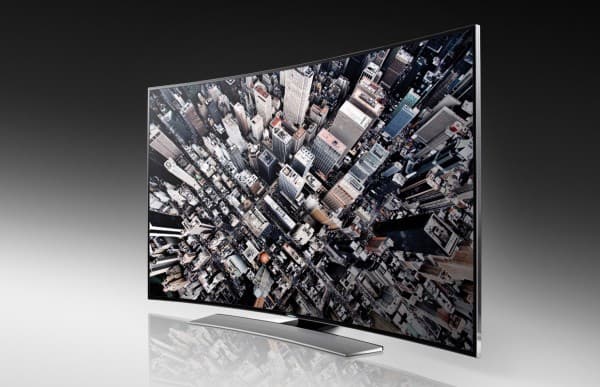
Is it time to replace the TV in your living room? Are you leaning towards the curved screen fantasy? If so, you might want to think again. Sure, a curved screen may create magic when the screen in substantially big, but on a living room size TV, it is little more than a gimmick. Here’s the flat-out truth on the Samsung UNHU9000, the world’s first and so far only LED LCD TV.
The impact of the curve on image immersion is barely noticeable.
The Samsung UNHU9000 has great picture quality, but if you want that promise of “immersive image” fulfilled, you are in for a disappointment. At least for purposes of everyday viewing, the image immersion is no greater than any flat screen TV of a comparable size. In fact, although the curve is obvious in person and from certain angles, it all but disappears when you watch the TV from your couch.
The curve may create slight geometric distortions.
While a flat screen TV is not without its own image distortion issues, you may find the distortions produced by the curved screen to be slightly more obvious. Most prominently, the curved screen creates a subtle bow-tie effect, with the sides of the screen appearing slightly larger than the middle. You will notice it the most when the image has horizontal lines stretching across the screen. Admittedly, it is not really obvious from the standard viewing position or distance which gives you basically the same viewing experience as it would with a flat screen TV. As you move off-angle, however, the distortions tend to increase.
The curve helps reduce reflections.
This may just about be the only picture-quality benefit you will notice on your curved screen TV. A flat TV reflects more of the surrounding objects – like a window, a lamp, or any shiny article – than does a curved screen TV. However, there is a flip side to this one, too. When it does reflect an object – a bright shirt worn by the viewer, for instance – the curved screen can actually increase its apparent size.
Curved TVs are considerably more expensive than flat ones.
At the 55, 65, and 78 inch sizes, Samsung’s curved UNHU9000 series presently costs you 44 percent, 30 percent, and 33 percent more respectively than the non-curved UNHU8550 TV in the corresponding sizes (55, 65, 75). The price difference adds up to about $1,000 for the smaller sizes and $2,000 for the bigger size. Of course, there are a few other feature differences between the HU9000 and the HU8550, but the curve by far outweighs them all.
Verdict:
The curved screen promoted as the marquee feature of the Samsung UNHU9000 is in fact more cosmetic than functional. The curve has a unique futuristic look that makes it one of the prettiest TVs in the market today. If it appeals to you aesthetically, go ahead and get it. But be prepared to pay heavily for it. And do not expect an appreciable change in your viewing experience.
Source: CNET
 Gearfuse Technology, Science, Culture & More
Gearfuse Technology, Science, Culture & More


